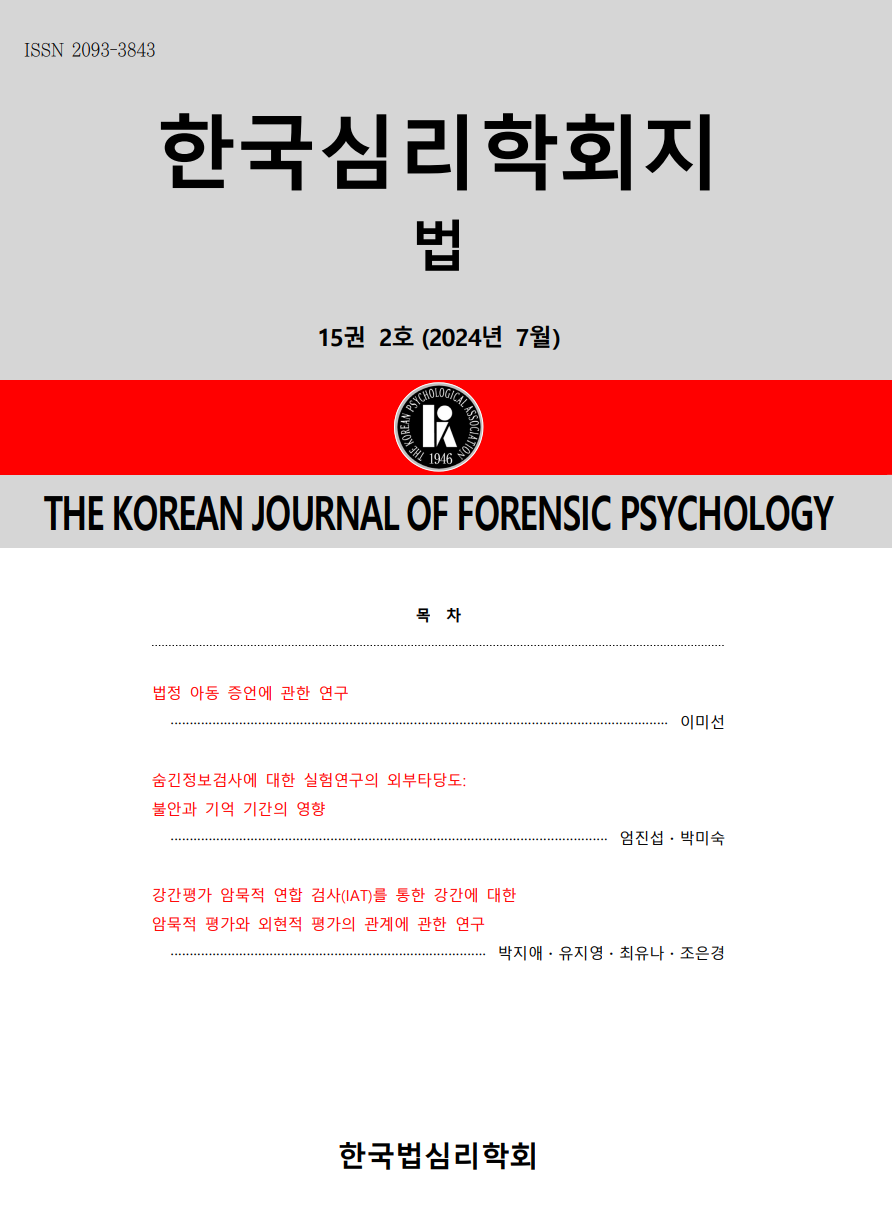open access
메뉴
open access
메뉴 ISSN : 2093-3843
ISSN : 2093-3843
The aim of this study is to investigate the effects of cognitive load and emotional arousal on liar’s gaze aversion. 112 participants were randomly assigned to four liar groups according to cognitive load and emotional arousal conditions (high cognition - high emotion: n = 29, high cognition - low emotion: n = 27, low cognition - high emotion: n = 29, low cognition - low emotion: n = 28). All participants were interviewed after lie tasks was performed, and gaze aversion was measured using a wearable eye-tracker. The high cognitive load condition had a significant higher gaze aversion than the low cognitive condition. There was no difference in gaze aversion among emotional arousal conditions. The interaction of cognitive load and emotional arousal was significant. In high cognitive load conditions, gaze aversion appeared with high frequency regardless of emotional arousal. In low cognitive load and high emotional arousal condition, gaze aversion appeared with low frequency. Therefore, this study suggests that it is necessary to consider the effects of cognitive load and emotional arousal levels on the liar‘s gaze aversion behavior.
For detecting deception research, the Concealed Information Test (CIT) is the most widely used method in conjunction with electroencephalography (EEG). Moreover, mock crime scenarios were commonly adopted for providing materials for lying. Mock crime scenarios have relatively higher ecological validity than other paradigms like autobiographical information or card test. However, current mock crime scenarios also have some limitations because of ethical issues, resource issues, and experimental controllability. Virtual reality (VR) is a potential alternative to overcome the disadvantages. Nonetheless, few studies used VR for mock crime, and there is no research on the comparison between ‘actual’ mock crime and ‘virtual’ mock crime. In the present study, we developed a high-fidelity virtual environment and used it for the virtual mock crime. Participants were randomly assigned both for the Crime status (innocent or guilty) and the Environment mode (actual or VR). After the scenarios, participants were tested by P300-based CIT with EEG recording. To verify the effects of virtual mock crime on subsequent EEG data during CIT, we focused on the P300 event-related component (ERP) and individual classification using the bootstrapping method in the study. As we hypothesized, the main effect of environment mode was not significantly different, and the interaction between stimuli type (target, probe, irrelevant) and environment mode was also not significant when we exclude one outlier. Furthermore, the accuracy of individual classification was equivalent between the actual and the VR. These results were also supported by ROC analysis and equivalence test. All statistical results suggest that there is no significant difference between actual mock crime and virtual mock crime. In conclusion, the study suggests that the virtual mock crime is a potential alternative method for mock crime scenarios.
Pre-Interrogation notification of suspect rights refers the provisions on right to refuse to make statement and assistance from attorneys before the interrogation of a suspect. This study investigate the effects of contents and methods of pre-interrogation rights notification on understanding of the suspect’s rights. Study 1 examined the words and concepts in the current notification of suspects rights with 31 college students and found that their understanding was low in terms including “whole statements”, “Assistance from attorneys” ect. Study 2 presented one of six conditions of different content(current notificiation/ reivised notificiation) and methods (oral/written/both) of pre-interrogation notification of suspect rights to 157 participants aged 19 or older and assessed their understanding of suspect rights. The current notification was the rights notification itself used in the investation and interview of suptes in the current legislation. The revised notification added explanations about legal terms of the current Criminal Orocedre Code and rivised them in easier expression based on the findings of Study 1. The results show that participants had a significantly higher understading of suspects rights when provided with the revised notification than the current one. There wrer on siginficant differences in their understadning of suspects rights before interrogations aorcding to the mthods of presenting.
This study classifies elder abuser into subtypes based on their profiles. 69 cases with abusers’ demographics, harmful characteristics, and abuse behaviors were retrieved from case books published by government agencies. Latent class analysis was used to categorize abusers based on 11 variables. Result showed that abusers fall into 4 profiles descriptively labeled “Mental disordered”, “stress explosive”, “dependent”, “economical burden” types. This result revealed abuser subtypes which are not able to be identified by analysis of abusing behaviors. Discussion and future research direction are discussed.